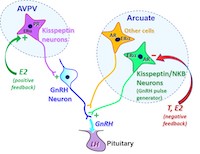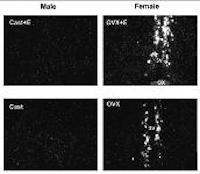Kauffman Lab
- Research
- Publications
- Contact Us
 The neural factors and mechanisms controlling fertility and the timing of sexual maturation remain to be fully elucidated. Kisspeptin signaling is essential for proper puberty onset and adult reproductive function in both humans and other mammalian species. Kisspeptin produced by Kiss1 neurons in the hypothalamus potently stimulates GnRH neurons, thereby activating the reproductive neuroendocrine axis. We use normal and transgenic mouse models to study various aspects of Kiss1 neuron development and regulation, and the pubertal and adulthood effects of kisspeptin and other brain neuropeptides/neurotransmitters (neurokinin B, dynorphin, GABA, glutamate, RFRP-3) on reproductive hormone secretion and fertility.
The neural factors and mechanisms controlling fertility and the timing of sexual maturation remain to be fully elucidated. Kisspeptin signaling is essential for proper puberty onset and adult reproductive function in both humans and other mammalian species. Kisspeptin produced by Kiss1 neurons in the hypothalamus potently stimulates GnRH neurons, thereby activating the reproductive neuroendocrine axis. We use normal and transgenic mouse models to study various aspects of Kiss1 neuron development and regulation, and the pubertal and adulthood effects of kisspeptin and other brain neuropeptides/neurotransmitters (neurokinin B, dynorphin, GABA, glutamate, RFRP-3) on reproductive hormone secretion and fertility.
 Androgens and estrogens, made by the gonads and elsewhere in the body, have potent regulatory effects on reproductive hormone secretion. These sex steroid effects occur via actions in the brain (positive and negative feedback), acting on kisspeptin neurons or other related reproductive neural populations. Exactly where and how androgens and estrogens exert their regulatory effects in the brain are not completely known. We are studying how these sex steroids alter kisspeptin neuron development and functioning and the consequences of such steroid actions on GnRH and LH secretion in various mouse models.
Androgens and estrogens, made by the gonads and elsewhere in the body, have potent regulatory effects on reproductive hormone secretion. These sex steroid effects occur via actions in the brain (positive and negative feedback), acting on kisspeptin neurons or other related reproductive neural populations. Exactly where and how androgens and estrogens exert their regulatory effects in the brain are not completely known. We are studying how these sex steroids alter kisspeptin neuron development and functioning and the consequences of such steroid actions on GnRH and LH secretion in various mouse models.
Sexual differentiation of reproductive neural populations
 Many aspects of the brain, physiology, and behavior are different between the sexes. Sexual differentiation of the brain (and the processes it controls) occurs during critical developmental periods and manifests later in life. Several aspects of the mammalian reproductive axis are sexually dimorphic, including the ability to generate a preovulatory “surge” of GnRH/LH or the timing of puberty onset. Given the critical role of kisspeptin in regulating the reproductive axis, we are interested in sex differences within the Kiss1 system, and investigating the mechanism by which these sex differences are developmentally produced.
Many aspects of the brain, physiology, and behavior are different between the sexes. Sexual differentiation of the brain (and the processes it controls) occurs during critical developmental periods and manifests later in life. Several aspects of the mammalian reproductive axis are sexually dimorphic, including the ability to generate a preovulatory “surge” of GnRH/LH or the timing of puberty onset. Given the critical role of kisspeptin in regulating the reproductive axis, we are interested in sex differences within the Kiss1 system, and investigating the mechanism by which these sex differences are developmentally produced.
